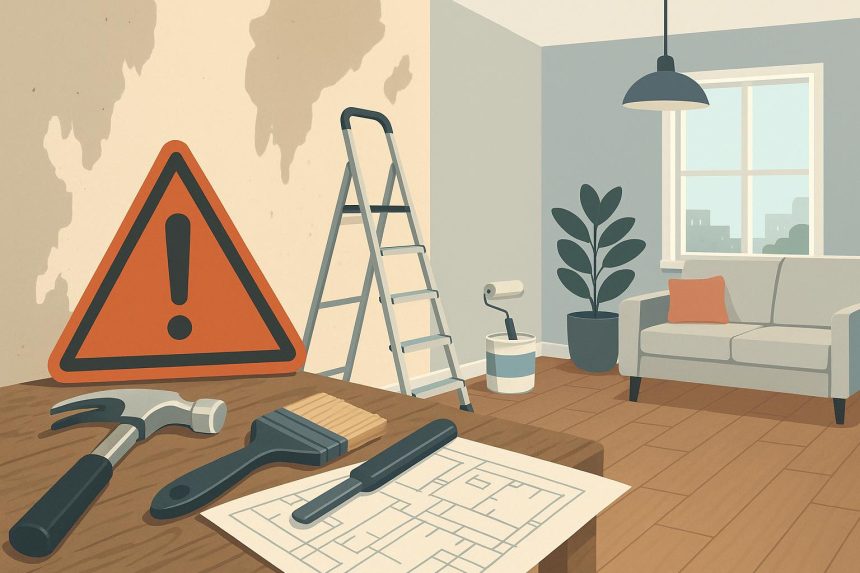You are about to begin on an exciting home renovation journey, but pitfalls could jeopardize your plans and budget. By understanding the common mistakes and missteps that homeowners make, you can keep your project on track and achieve the results you desire. This vital guide will arm you with practical advice and insights to help you navigate the complexities of home renovations in 2025, so you can transform your space without undue stress or expense.
Types of Home Renovations
A successful renovation begins with understanding the various types available. You can choose to enhance your living space through different approaches:
- Interior Renovations
- Exterior Renovations
- Structural Renovations
- Eco-Friendly Renovations
- Luxury Upgrades
Thou need to assess your needs, budget, and design goals to decide which types of renovations best suit your home.
| Type of Renovation | Description |
|---|---|
| Interior Renovations | Transform your indoor spaces for improved functionality and aesthetics. |
| Exterior Renovations | Enhance your home’s curb appeal and protect its structure. |
| Structural Renovations | Modify or reinforce the home’s structural elements. |
| Eco-Friendly Renovations | Incorporate sustainable materials and energy-efficient designs. |
| Luxury Upgrades | Add high-end features for a more luxurious lifestyle. |
Interior Renovations
Little changes in your interior can make a big difference. From updating your kitchen to redesigning your living room, optimally planned interior renovations can elevate your home’s style and comfort level, creating a more inviting atmosphere. You should consider aspects such as layout, color schemes, and lighting to enhance your everyday living space.
Exterior Renovations
Home renovations are not only limited to the interior; enhancing your home’s exterior is just as important. Upgrading features like siding, roofing, and windows can significantly impact your home’s value and energy efficiency. You can also focus on improving landscaping, decks, and patios to create an inviting outdoor space.
This transformation of your home’s exterior not only boosts curb appeal but also plays a vital role in protection from the elements. Choosing the right materials and designs will ensure your home remains appealing while providing durability. It’s important to consider your local climate and community aesthetics, so your renovations reflect both personal style and future resale value.
Key Factors in Renovation Planning
Any successful home renovation starts with a well-thought-out plan. You should consider the following key factors to set the stage for a smooth process:
- Your goals and objectives
- Budget constraints
- Building regulations and permits
- Choosing the right professionals
- Material selections
Knowing these factors will significantly enhance your renovation experience.
Budget Considerations
Even the most brilliant renovation ideas can falter without a realistic budget. Take time to outline all potential costs, including labor, materials, and unexpected expenses. This foresight will not only prevent financial strain but also help you prioritize your desires while staying on track at River Modern.
Timeline Management
One of the most important aspects of renovation is managing your timeline effectively. Establish clear deadlines for each phase of the project to keep everything on schedule and minimize stress.
Plus, an effective timeline will allow you to coordinate with contractors and suppliers, ensuring that every element arrives and is completed as planned. This organized approach will help you avoid bottlenecks and allow for adjustments in case of unexpected challenges. Staying flexible within your timeline can also lead to better overall results for your renovation project.
Essential Tips for Successful Renovations
Clearly, successful home renovations rely on strategic planning and execution. Here are some necessary tips to help you navigate the process:
- Establish a clear budget.
- Set realistic timelines.
- Choose quality materials.
- Communicate effectively with your team.
- Stay adaptable to changes.
Thou shalt not shy away from seeking expertise when needed.
Research and Planning
You must prioritize research and thorough planning for your renovation project. Start by defining your goals, exploring design ideas, and determining your budget. Consider your home’s current condition and how it aligns with your desired changes. Take the time to gather inspiration from various sources, such as magazines, websites, and home improvement shows, to ensure a clear vision that guides your renovation journey at Narra Residences.
Hiring Professionals vs. DIY
Now, determining whether to hire professionals or commence on a DIY journey can significantly impact your renovation’s success. Assess your skill level and the complexity of the project when making this decision. While DIY can save costs, it often requires a significant investment of time and effort, not to mention the risk of costly mistakes. On the other hand, professionals bring experience and expertise, ultimately leading to a more polished result.
Hiring experienced professionals for your renovation can lead to more efficient and higher-quality outcomes. While DIY projects can be rewarding, they often require extensive knowledge and skills that you may not possess. Engaging experts ensures that the work meets industry standards and adheres to local regulations. Additionally, professionals are adept at managing unexpected challenges, allowing you to focus on design and aesthetics while they handle the technical details. Invest your time wisely and consider how much you value your own time and peace of mind throughout the renovation process.
Step-by-Step Renovation Process
All home renovations benefit from a structured approach. By following a step-by-step process, you can avoid common mistakes and ensure a smoother journey. Here’s a breakdown of the important stages involved in your renovation project:
| Stage | Description |
|---|---|
| Initial Design & Approval | Conceptualize your ideas and secure the necessary permissions. |
| Execution | Implement the design, managing contractors and timelines. |
| Final Touches | Add details that personalize and complete your space. |
Initial Design and Approval
Even the best renovation plans begin with a well-thought-out design. Outline your vision, budget, and timeline while ensuring that your designs comply with local building codes and regulations. Securing the necessary approvals can prevent delays in the execution phase and sets a strong foundation for a successful renovation.
Execution and Final Touches
For your renovation to truly shine, careful execution is vital. This phase involves coordinating with contractors to bring your design to life and regularly checking in on progress to stay on schedule.
Initial attention to detail during the final touches can transform your project from good to great. Whether it’s selecting the right paint colors, choosing fixtures, or adding decorative elements, these details reflect your personality and enhance the overall aesthetic. Investing time in this stage ensures your space looks cohesive and welcoming, making your renovation effort worthwhile.
Pros and Cons of Common Renovation Choices
To navigate the complex landscape of home renovations, it’s crucial to weigh the advantages and disadvantages of common choices you may face. Below is a concise overview to guide you in making informed decisions:
| Pros | Cons |
|---|---|
| Increased home value | Higher initial costs |
| Improved functionality | Potential for costly overruns |
| Enhanced aesthetic appeal | Disruption during renovation |
| Energy efficiency upgrades | Time-consuming processes |
| Customization to your tastes | Need for permits and regulations |
Upgrading vs. Expanding
Some homeowners face the decision between upgrading existing spaces or expanding their homes. Upgrading often focuses on enhancing what you already have, such as new fixtures or advanced technology, which can improve efficiency and style. Alternatively, expanding provides more space but can entail greater costs and potential structural issues. Carefully evaluating your needs will ensure your choice aligns with your long-term goals.
Sustainable Materials vs. Traditional Materials
Clearly, the choice between sustainable and traditional materials weighs heavily on both environmental impact and budget. Sustainable materials can often be more expensive upfront, but they are better for the planet and can lower future utility costs. Traditional materials, while often less costly, can contribute to environmental harm. You’ll want to evaluate what aligns with your values and lifestyle.
It is crucial to consider the broader implications of using sustainable materials versus traditional options. Opting for renewable resources, such as bamboo or reclaimed wood, can reduce your ecological footprint and improve indoor air quality. Additionally, these materials often lead to lower energy consumption, making them a wise long-term investment. Think about your renovation’s impact not just on your home, but on the environment as well, as this choice can resonate far beyond your immediate needs.
Avoiding Common Renovation Pitfalls
Keep yourself informed about the common renovation pitfalls that can derail your project. Understanding these issues allows you to proactively address them, ultimately saving time, money, and frustration. From budgeting wisely to selecting the right contractor, being aware of potential missteps will enhance your renovation experience and create a more enjoyable journey towards your dream home.
Over-Improving Your Home
Clearly, enhancing your home is part of the renovation process, but over-improving can be detrimental. You need to ensure that your upgrades align with the neighborhood’s standards and home values. Otherwise, you risk spending more on renovations than you can recoup when selling. Aim for a balance that elevates your home while remaining relatable to future buyers.
Ignoring Local Regulations
Ignoring local building regulations and codes can result in costly fines and the need to redo work that does not meet standards. While navigating these requirements may seem tedious, it is vital for the safety and legality of your renovation. Compliance not only protects your investment but also enhances the overall appeal of your property.
Another significant concern is that local regulations often include permits that must be obtained before beginning work. Your local government establishes these rules to ensure that construction projects meet safety and zoning standards. Failure to secure necessary permits can lead to penalties or even the requirement to dismantle completed work. Additionally, inspection processes can further delay your renovation, so it’s best to stay proactive and fully aware of what is required in your area.
Summing up
As a reminder, navigating home renovations in 2025 requires careful planning and awareness of common pitfalls. By leveraging the insights provided in this guide, you can enhance your decision-making process and mitigate risks associated with budget overruns, timeline delays, and choosing the wrong contractors. Equip yourself with the knowledge to ask the right questions and set realistic expectations, ensuring that your renovation journey is both rewarding and successful. Your careful preparation can lead to a transformation that meets your vision while safeguarding your investment.
Lynn Martelli is an editor at Readability. She received her MFA in Creative Writing from Antioch University and has worked as an editor for over 10 years. Lynn has edited a wide variety of books, including fiction, non-fiction, memoirs, and more. In her free time, Lynn enjoys reading, writing, and spending time with her family and friends.















